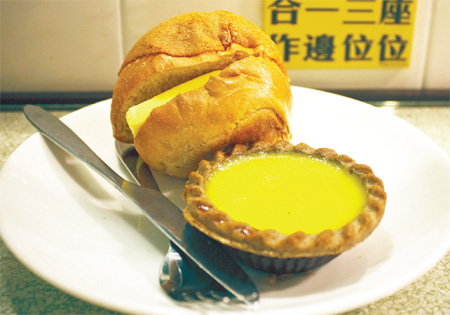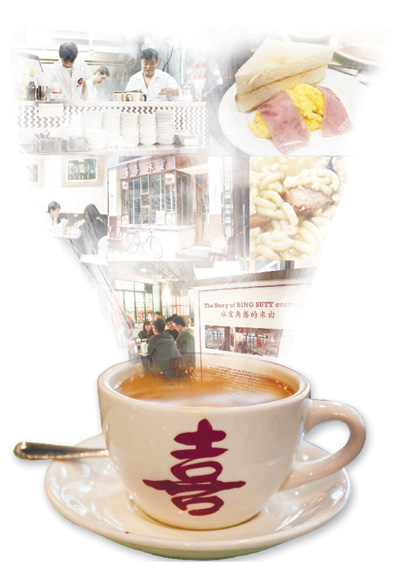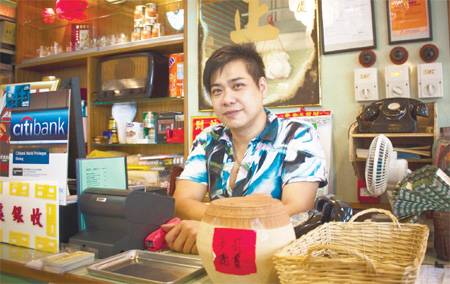Being subtle no part of bing sutts
Updated: 2010-07-31 07:56
By Christopher Dewolf(HK Edition)
|
|||||||
Offering and preserving a nostalgic, yet eclectic fusion of foods of East and West, these quirky, campy cafes can be as hard to find as they are easy to enjoy. Christopher Dewolf tells their lively story.
It looks like any other Starbucks - until you gaze past the espresso machine and notice a scene straight out of a vintage Hong Kong movie. Handwritten menus are taped to the walls, birdcages hang from the ceiling and green-framed windows open onto a landscape of big-character signs.
In a nod to Hong Kong's original cafe culture, the Duddell Street Starbucks in Central has recreated a vintage bing sutt, an informal kind of restaurant popular in the postwar years that serves eggs, sandwiches, pasta soups and iced drinks (although the Starbucks bing sutt limits itself to coffee-flavored pineapple buns, egg tarts and Swiss rolls).
"We wanted to come up with something unique that could represent Hong Kong's past," says Teresa Shum, Starbucks' public relations manager. "Bing sutts in the past served the same purpose as Starbucks. It was a place for people to connect to each other, to family and friends."
In the 1950s, 60s and 70s, bing sutts were found throughout Hong Kong, but they have since become a rarity, with no more than a few dozen left in the entire city. Now they seem poised for a comeback. Over the past year, several new bing sutts have opened on Hong Kong Island, drawing interest from a young generation smitten by the romance of nostalgia and fascinated by Hong Kong's heritage.
"I used to go to these places with my parents as a special treat," says Douglas Young, the founder of lifestyle store G.O.D., who designed the Starbucks bing sutt. "The atmosphere is one of informality and liveliness because it is hot and noisy, it is also a special blend of Western materials put together according to local taste."
Restaurateur Li Shing, 46, dreamed of opening a bing sutt since he returned to Hong Kong after living for 15 years in Australia. "The times I went to this kind of restaurant when I was young were the best times of my life," he says. Scrambled eggs and deep-fried French toast were his favorite dishes. "When we were students, my friends and I didn't have much pocket money, so after school, we would sit in a bing sutt for hours. It was a place to be ourselves without control from our parents."
Earlier this year, Li opened Cafe Match Box, a restaurant in Causeway Bay with the tile floors, wooden booths and 1970s-era Cantopop soundtrack that pay homage to the bing sutts of yore. With the help of a film industry art director, the restaurant was filled with mirrors, vintage posters and retro light fixtures - all of them new, but meant to look old.
"It's good fun," says Li. "We've all got income from our other businesses, so we did this not for the money, but for our own interest and memories."
That sentiment extends to the menu, which includes bing sutt staples like red bean ice, milk tea and macaroni soup, but also some old favorites that have disappeared from most contemporary menus, like hot water egg. "In Chinese, we call it 'a monk jumped into the sea,' because you put an egg in a cup of hot water with a bit of sugar, and the yolk floats on top, which looks like the top of a monk's bald head," says Li.
There are some innovations, of course. One of Match Box's set meals includes a chicken pie floating in green bean soup - a decidedly unorthodox way of serving an otherwise traditional pastry. "People said: 'You're crazy! People will never eat that, they'll think it's disgusting,'" says Li. It turned out to be one of the most popular items on the menu. The key, it seems, is to stay true to the spirit of bing sutt food: "Simple and direct," as Li puts it.
The kind of food served in bing sutts falls under the umbrella of what is commonly termed "soy sauce Western," which is to say European and North American dishes prepared according to Chinese tastes. Their exact origins are unclear, but classic Hong Kong food items like egg tarts, milk tea, chicken pies and pineapple buns are believed to have sprung from contact between colonial Europeans and local Cantonese in the early 20th century.
The origins of bing sutts are even murkier. One theory suggests they evolved from traditional herbal tea houses that began selling cold Western-style soft drinks, hence their name, which literally means "ice house." In any case, they became popular as the Hong Kong equivalent to the Italian espresso bar - a local hangout where people could grab a comforting drink and a light meal.
"A bing sutt, for me, is very neighborhood-oriented," says Sidney Cheung, a professor of anthropology at the Chinese University of Hong Kong. "You go there for a break, for breakfast to get some toast or get some bread like bolo bau." Over the years, though, some bing sutts began offering more elaborate dishes, blurring the distinction between a bing sutt and other types of restaurants.
Those riding the new wave of bing sutts are keeping it simple. "It needs to be clean, bright and have good quality food, but the menu doesn't need to be too big," says Raymond Chan, the owner of Capital Cafe, a Wan Chai bing sutt he opened last year with a childhood friend. "We grew up in the 1960s and 70s and didn't have air conditioning at home, so we went to bing sutts. The atmosphere is so lively, there's a real spirit. It's part of our memory."
While the menu at Capital Cafe is more straightforward than at Match Box - there is no chicken pie soup here - it hasn't completely emulated the traditional bing sutt. The vintage black-and-white booths and floor tiles are complemented by a rotating collection of contemporary photos and paintings. The beef in the macaroni soup is halal ("It's better quality," says Chan), the milk in the eggs is imported from Hokkaido and the staff are uniformly friendly - not always the case in older bing sutts, which have a reputation for surly service.
"We've taken the bing sutt as a model, but it's not a perfect model," says Chan. "We've tried to improve on it by making sure everything is clean, fresh and the service is good." He achieved the latter goal, he says, by paying his staff higher wages than at other restaurants, which often offer their staff less than HK$30 per hour.
The effort seems to have paid off. "We came the first day and have come every Saturday since," says middle-aged customer Tim Lau, dipping a thick slice of toast in the remnants of a fried egg. "My father always took me to this kind of place, but there are very few of them left." Her teenage son, Horatio, says the decor felt "quite old," but he likes the food - enough to visit three times a week.
That kind of loyalty has always been a part of the bing sutt experience. Kei Heung Bing Sutt has been on Victory Avenue in Ho Man Tin for 38 years. In that time, says 62-year-old owner Kwan Kin-ming, he has seen his customer's children grow up, have kids of their own and bring them to eat at Kei Heung.
"I've heard all about these new places," he says. "The furniture, the decor can be imitated, but whether they can be successful depends on whether they have the heart and the same spirit as an old place like this." As he spoke, a woman in her 30s was paying her bill. "He's right," she says. "I first came here when I went to kindergarten nearby. I'm still here."

|
Restaurateur Li Shing opens a bing sut named Cafe Match Box in Causeway Bay earlier this year. Bing suts were once popular in the 1950s, 60s and 70s. Provided to China Daily |

(HK Edition 07/31/2010 page4)
